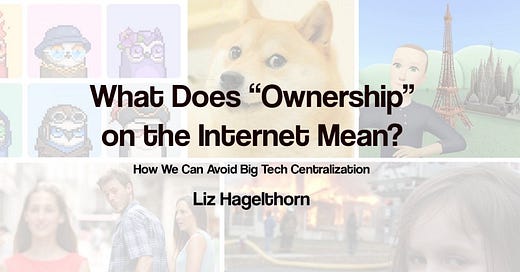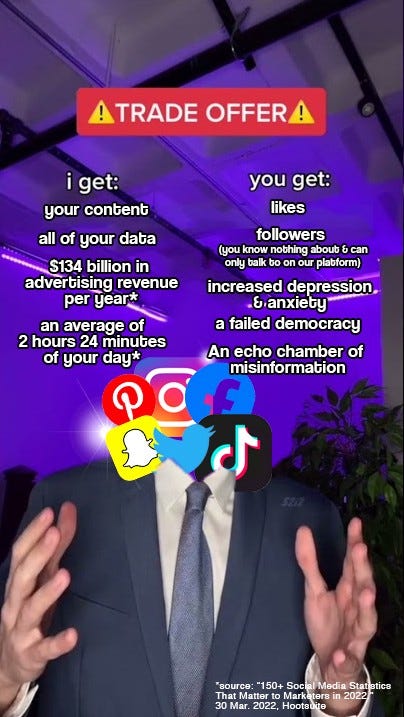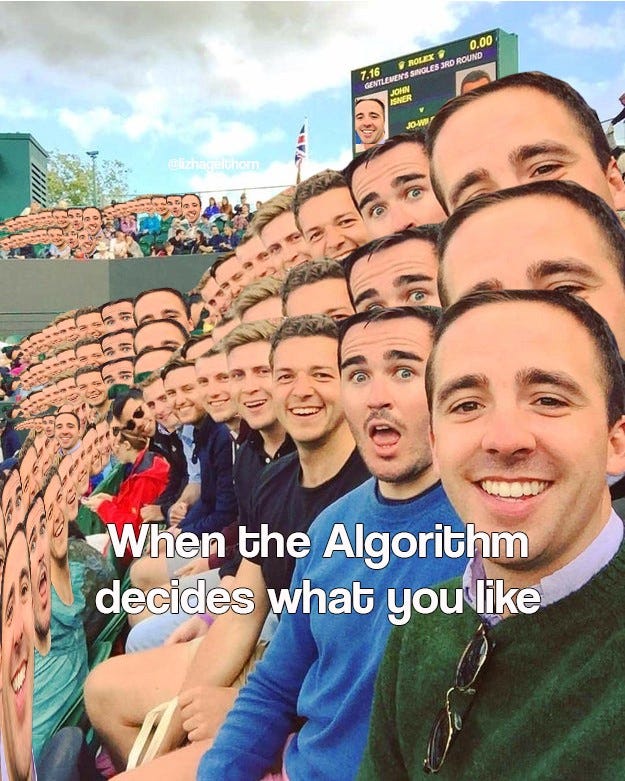What Does “Ownership” on the Internet Mean?
How We Can Avoid Big Tech Centralization All Over Again
How We Can Avoid Big Tech Centralization All Over Again
Liz Hagelthorn is a social-first storyteller and meme-maker with a diverse background in meme culture, technology, and organic virality. Liz is best known for leading creative for the largest pseudonymous meme network on Instagram, overseeing creative strategy across 100+ accounts with 300M followers and reaching 1.2B people per month. Most notably, Liz was the face and creator behind the @girl account. She led the network’s acquisition in under two years.
Liz has held positions at Google and Twitter, and works with high-profile startups and celebrities to develop viral organic growth strategies, In 2021, Liz led a web3 artist and developer collective to create the first Ethereum gas tool for NFT artists and collectors to better understand platform fees. She is also the creator and host of Girl Gone Viral, a podcast featuring interviews with creative entrepreneurs, online community builders, and academics about how storytelling on the internet really works.
Liz is currently Director of Social & Content at Coil, a service that provides additional methods for content creators to monetize their work online. Liz graduated with a Bachelor of Arts from the University of California, Berkeley. Follow her on Twitter @lizhagelthorn.
The Internet’s unwritten rules are changing. The new rules, if implemented correctly, could mean expansive new ways to earn a living from it.
The products and services that define the internet are evolving into a new phase, commonly known as web3. Web3 potentiates ownership of digital assets, products, and services using blockchain technology. It represents a new evolution of the internet that shifts power from Big Tech platforms and advertising-based business models to a decentralized online ecosystem owned by its users.
For creators, web3 offers an incredible opportunity to build, grow, and monetize audiences on a decentralized platform. But how do we prevent moving from one big platform, such as Instagram or Twitter, to another, such as OpenSea or Discord, only to experience the same centralization problems?
“The playbook is still being written, but one thing is certain: ownership is becoming a keystone of new experiences across all categories of software products.”
Everybody? Online? Making money? That is the dream.
A Global Creativity Crisis
How the centralization of social media platforms created a creativity crisis and what we can learn from it.
The current model of digital ownership is in direct conflict with our ability to create meaningful aesthetic work and communicate with each other. It hinders the innovation necessary to drive a healthy economy; it creates algorithmic-driven content churn that leads to social fatigue and stunted creativity; and it creates advertiser monopolization of creator energy and audiences. Web3 skeptic or not, the current centralization of the internet is preventing innovation and the development of a more equitable, creative online world.
Currently, the power of the internet is in the hands of the social media companies that write and control social media algorithms. They determine the spread of information and create the distribution channels. Along the way, they extract $134 billion in advertising revenue per year from content that users provide for them at no cost.
In other words, the current Internet ownership structure allows a few central players to exploit our digital lives, content, and connections for profit while gatekeeping the type of content we make. The creators making a living online are at the mercy of these platforms; if the platforms change their rules or algorithms, creators are forced to course correct on the spot and follow new rules, which are more likely to serve the platform’s interests than the creator’s.
Innovation, Interoperability and Data Portability
Web2 (aka 2004 to present day), marked the Internet’s transformation from “read-only” to “read-write”. When social media platforms, like MySpace, Facebook, and Twitter, created spaces for user-generated content, it was no longer just corporations creating digital content for others to see.
However, unlike corporations, the content creators building audiences on these platforms have very little ownership over their work. They can’t export their own content or collect contact information from their hard-won audiences, but they’re forced to stay on these platforms if they want to continue to reach people. Meanwhile, the social media platforms receive massive growth and profits powered by user content. For example, Facebook launched in 2004, and by 2018, it had more than 2.26 billion users.
In June 2019, the Committee on the Judiciary initiated a bipartisan investigation into the state of competition online, finding that the rise of market power has materially weakened innovation and entrepreneurship in the U.S. economy. Some venture capitalists, for example, report that there is an innovation “kill zone” that insulates dominant platforms from competitive pressure simply because investors do not view new entrants as worthwhile investments.
Not only do web2 social media platforms stifle innovation, but users don’t receive compensation from platforms for creating the content that drives people to them. Worse, platforms like YouTube and Instagram have algorithms that incentivize users to post more and more content per day if they want to generate engagement. This allows platforms to sell more and more advertisements that can be served against that content and keep people on their platforms longer. But it only serves to burn out creators.
Algorithmic-Driven Creativity & Fatigue
Creativity and storytelling happen through the art of the process; not the intended result.
To preserve authentic communication, content, and control over our digital lives, we need to change our current concept of online ownership. The internet is where many of us work and live, which allows algorithmic-driven products and apps to take complete control over our digital lives. These interferences hinder our ability to form authentic connections, create original content, and develop innovative products and services.
In his book Taste, Giorgio Agamben discusses the relationship between algorithms and what drives human desire to discover things we like. Agamben argues that taste is an essentially human capacity; we know if we like something before we understand why.
This effect is principally founded on surprise. Algorithms are designed to pleasantly surprise you through relevant and timely recommendations, yet we are never quite surprised because algorithmic-driven content speaks to the masses, leading to a lack of originality and the production of almost identical products.
In addition to unoriginal products and services, the constant creative content churn required by dominant social media platforms is a fast-track to burnout and social media fatigue for content creators. After surveying 127 Instagram accounts totaling 300 million followers between 2019 and 2021, researchers learned that that an account with 1 million followers needs to post seven times per day to continue growing a substantial following.
Online platforms do not pay creators to post this many times per day. However, if you want to make a living from artistic work hosted on a dominant platform, you need high followings and engagement to negotiate brand deals.
Alternative business models for the web could not come at a more necessary time. The most recent generations are burned out, poor, and lonely. Although dubbed the Creator Economy, one has to question whether a creator might have ever envisioned this economy.
Advertiser Monopolization of Creativity and Perspective
Advertising-based business models do not help artists or creativity flourish; quite the opposite. Have you ever heard the saying “life imitates art”? What happens when most of the art we see is actually subtle advertising?
Digital marketing experts estimate that most Americans are exposed to around 4,000 to 10,000 advertisements each day. Opening Instagram, Twitter, LinkedIn or any other social media app is like seeing an advertisement of every person you know.
As a collective, we have internalized ad-based storytelling, and we use it to tell and sell our own stories through highlight reels of the very best moments of our lives. The internet is a hall of mirrors, and if what we find interesting, who we follow, and what we relate to are grounded in advertisements, we inevitably become advertisements ourselves.
We want to sell ourselves so badly that we use apps like FaceTune to look more presentable, more sellable, like the celebrities we see in magazines and movies. But what happens when celebrities are the ones removing their own insecurities to the point they no longer look human? The cycle continues. We come to “social media” to be social, to connect, but how can you feel connected to someone promoting themselves in a highly un-relatable way for likes? Everyone ends up feeling more alone and depressed. This cycle is not healthy or sustainable for the creator or the consumer.
With the rise of the Creator Economy and web3, creators are empowered to own their audiences without needing to cater to brands or rely on the norms established by dominant social media platforms.
Currently, in web2, there are 50 million “creators” and 2 million can earn a full-time living creating content. Of the 2 million full-time creators, approximately 75% of their income comes from brand deals. This means that creators need to find sponsors, write contracts, and create sponsored content, aka advertisements, just to pay bills. But imagine how creativity can flourish when creators aren’t forced to focus on promotional brand content to make a living.
Web3 business models and tools are massive opportunities for creators to start shifting their content strategy to one that better benefits them and their audiences. Web3 also offers the opportunity for platforms to create tools and features that usher in the new era of the decentralized Internet. It’s an era that can be owned by users and shift the labor paradigm to allow for multiple streams of income for content creators’ time, money, and creative assets.
Internet Ownership of Assets Manifesto
As we imagine the future of the internet, various possibilities emerge. This exploration can include various design options both on- and off-chain that create environments conducive to creativity, communication, technological innovation, and payments. This is a critical moment to reconceptualize online ownership.
The following 13 recommendations can help to define ownership on the web. These are meant to inspire builders and storytellers who want to create web2 and web3 products and services that lead to a user-owned Internet.
1.Ownership should include the ability to buy, trade, license, and sell digital assets easily across the globe. Platforms and marketplaces should allow owners of individual NFTs, digital assets, and goods to:
Set prices, Decide sale mechanisms (direct, auction, open to offers), List for sale, License market participation, Fractionalize sales, Commission incentives and architecture for curators to earn, Split profits, Initiate trades, Facilitate account transfers and username sales, Accept tips.
2. Ownership should include the ability to download digital assets in the file type, size, and resolution chosen by the original creator and made explicit before the purchase. Platforms should provide the original creator with the option to choose what format, aspect ratios, or files they want to make downloadable
3. Ownership should include the ability to link out to an external URL. Platforms and marketplaces should allow owners of individual NFTs, digital assets, and goods to add their own:
Website links, Social media profiles, Discord channels, Podcasts, Songs and streaming services, Forms and other questionnaires for visitors, Decentraland, Sandbox or other Metaverse land where a character lives, Press articles, Other NFTs and profiles.
Web3 is a massive opportunity for people to create brands, storylines, characters and social networks just from owning one digital asset or good, including NFTs. For example, California-based restaurateur and Bored Ape Yacht Club (BAYC) #6184 Andy Nguyen opened Bored and Hungry, a burger restaurant in Long Beach, California. If ones looks at BAYC #6184 on OpenSea, it would be nice to see the website or press articles associated with the asset.
4. Ownership should include the ability to add captions and change the context and/or descriptions of creator assets.
Platforms and marketplaces should allow owners of individual NFTs, digital goods, and assets to write their own captions, descriptions, and messages.
If a marketplace creates this feature off-chain and the piece is sold to another wallet, the caption should disappear.
5. If marketplaces and platforms allow for commenting by other users, ownership should include the ability to moderate any comments
Platforms and marketplaces should allow owners of individual NFTs, digital goods, and assets to:
Turn comments on/off, Delete comments, Block users and wallets from commenting, Block certain phrases and terms used in comments, Report comments and wallets who engage in abuse, harassment, or spam, Add links in comments, Like or pin comments to the top of the discussion, Add images, videos, and other owned media in comments
This is not great.
6. Ownership should include the ability to gate access to creator assets.
Platforms and marketplaces should allow owners of individual NFTs, digital goods, and assets to:
Control access to buy or trade, Limit views and edit access to chosen audiences, Control visibility of revealed assets (for example, the public may be able to see that you have an asset in your wallet, but not which one)
7. Ownership should include creator asset analytics
Platforms and marketplaces should compensate owners of individual NFTs, digital goods, and assets for:
Any analytics the platform or marketplace collects, such as views, devices, traffic sources, and other audience data
Analytics obtained from links or spaces where the asset is publicly shared via custom links (the red arrow line, below) that host the content
Information obtained from the platform’s search function
Ability to download analytics into raw data (.csv file or similar)
8. Ownership should include the ability to track asset sales and postings across the internet
Platforms and marketplaces should provide owners of individual NFTs, digital goods, and assets access to the full purchase history of an asset.
A future technology could allow owners to view and track where their assets are posted. For example, if you make a meme and post it to Twitter and Instagram, there should be a dashboard tied to the meme that shows you those two posts, along with posts from anyone who screenshot or took that meme for their own use or modification. This technology could be similar to song detection for DMCA takedowns, but used for all digital assets. This would be the foundation of a thriving licensing market on the Internet, providing a fair incentive for meme makers everywhere.
9. Ownership should include rights that are defined prior to transaction for the purposes of empowering the owner, such as the right to:
Post across socials, Use as profile pictures, Photoshop or manipulate, Create animations from the original, Merchandise, License, Earn revenue from being displayed or distributed by the creator (for example: if you buy a .0001% of a Taylor Swift song, you can earn revenue from streams)
10. Ownership should include the ability to add, split, or delegate other ownership parties to an individual asset
Co-post with another account/wallet/user/fill in the blank, Split earnings, Delegate administrative rights to another user or wallet
10. Ownership should include the ability to build a following, collect subscribers, gather email addresses, and/or implement a notification or messaging system that alerts interested users to the activity of an individual NFT, digital good, or asset
Alternatives include: Asset based audiences (building an audience or community around one asset), Ownership based (building an audience or community who splits ownership of an asset), Wallet based (building an audience or community around a certain on-chain wallet)
11. Ownership should include the ability to quantify or present value upgrades, additional media, or other material purchased or sold with an individual NFT, digital good, or asset
Individual asset owners have been massively successful in creating and growing loyal followings as the identity of their NFT. For example, on Twitter, Cryptopunk #6529 has gained almost 400,000 followers and established themselves as a leading voice within the crypto and NFT space despite nobody knowing their true identity.
In this way, each asset has the ability to translate into an identity that accrues social and economic capital. This allows an owner to create value independent of their identity. Ultimately, that goodwill can be transferred with the asset in subsequent transactions.
Marketplaces should allow owners to quantify or present any value upgrades. Any assets created that are associated with the digital asset, such as a Twitter handle, should be sellable along with the media.
12. Ownership should include the ability for creators to earn advertising revenue related to the storage of their asset across the internet
To the extent that the asset’s host, such as a platform or marketplace, earns ad revenue from particular assets, the host should have a mechanism to share that revenue with the asset’s creator. For example, if OpenSea sells advertisement slots, such as banner ads, then owners of assets featured on the page where the banner appears should receive most of the revenue.
If you are investing in the meme and content space or are interested in this topic, I’d love to talk to you. My Twitter DMs are open @lizhagelthorn.
If you want to understand how the desire for online ownership is driving changes to the digital economy, Variant Fund’s “The Ownership Economy 2022” offers a useful primer on the importance and potential of web3, including the vision and market opportunity discussed in this piece.








